Sony has long ploughed its own smartphone furrow, supporting a wide 21:9 screen that makes for taller handsets than usual and lends itself to video consumption. Xperia phones target three price bands: Xperia 1 is the flagship, Xperia 5 covers the mid-range, and Xperia 10 is the entry-level model, vying with mid-range priced phones from other makers. I’ve already looked at the latest Xperia 1 III which turned out to be well featured but expensive. How does the £399 (inc. VAT) Xperia 10 III fare? (At the time of writing, the Xperia 10 III is not officially available in the US.)
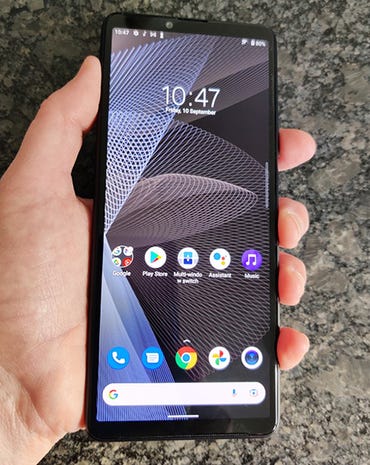
The 6-inch Xperia 10 III is powered by Qualcomm’s Snapdragon 690 5G chipset with 6GB of RAM and 128GB of internal storage (expandable via MicroSD at the expense of a second SIM).
Image: Sandra Vogel / ZDNetBy modern standards this 6-inch phone is a small handset. It measures 68mm wide by 154mm deep by 8.3mm deep, and slipped neatly into any of my pockets. Although I could reach across the screen, that 21:9 aspect ratio makes for a tall screen, so I couldn’t do full-finger sweeps one-handed. Many people will, therefore, have to use both hands to navigate the Xperia 10 III.
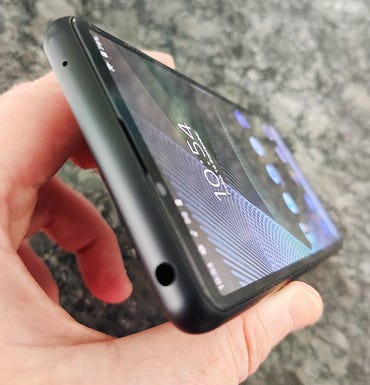
The 3.5mm headset jack is on the top edge.
Image: Sandra Vogel / ZDNetAt 169g, the Xperia 10 III is noticeably heavier than last year’s 151g 10 II model, thanks mainly to an increase in battery capacity (4500mAh versus 3600mAh).
SEE: Smartphone sales are riding out the global chip shortage
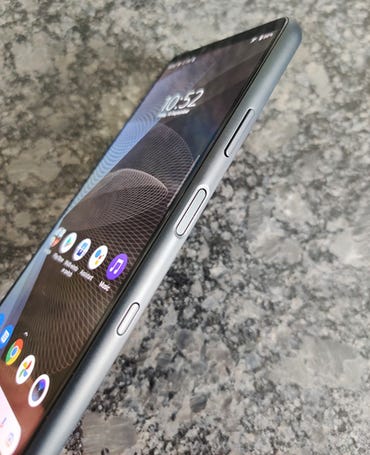
Right side buttons (from top): volume rocker; power/fingerprint reader; Google Assistant.
Image: Sandra Vogel / ZDNetSony continues with its distinctive, squared-off, somewhat monolithic design. My review unit’s black back fades to grey in some lighting (the Xperia 10 III is also available in blue and white). Immediately out of the box it looked great, with its shiny Gorilla Glass 6 back. However, within five minutes it was covered in fingerprints and looked considerably less smart. It’s also very slippery and failed my ‘sofa test’ abysmally, falling off the arm apparently at will with remarkable frequency.
Like its predecessor, the Xperia 10 III has a 3.5mm headset slot on its top edge. The left edge houses the SIM caddy with a fingernail slot for easy removal. You can install two SIMs or one SIM and a MicroSD card — the Xperia 10 III is a 5G phone, powered by Qualcomm’s Snapdragon 690 5G chipset.
The fingerprint reader is built into the power button on the handset’s right edge. Above this is a volume rocker, and below it there’s a Google Assistant shortcut. Pressing the power button twice starts the camera, making it easy to capture images quickly when the phone is on. The Xperia 10 III has IP65/68 certification, which means it is ‘dust tight’, and can handle ‘water jets’ and immersion in up to 1.5m of water for 30 minutes.
The 6-inch OLED screen sits in sizeable top and bottom bezels, resulting in a moderate screen-to-body ratio of 80.3%. The top bezel houses the front camera, minimising interference with the screen. The screen is sharp, with a resolution of 2,520 by 1,080 pixels (457ppi). However, brightness could be better, making outdoor viewing on sunny days a challenge.
Video is a mixed experience: when it’s shot in 21:9, video is a pleasure to watch. But with other content, such as catch-up TV, there are borders, sometimes annoyingly thick, around the image. The screen’s 60Hz refresh rate feels a little behind the times too, considering this is a handset where video is a major selling point; 90Hz or 120Hz, as on the Xperia 1 III, would be preferable, although the latter would boost the cost.
The Snapdragon 690 5G chipset, accompanied here by 6GB of RAM, is far from a powerhouse by today’s standards. Under Geekbench 5 the Xperia 10 III delivered CPU scores of 548 (single core) and 1601 (multi core). That’s close to the results achieved by Motorola’s £199.99 Moto G50 (501 and 1583) and Samsung’s £349 Galaxy A52 5G (642 and 1659).
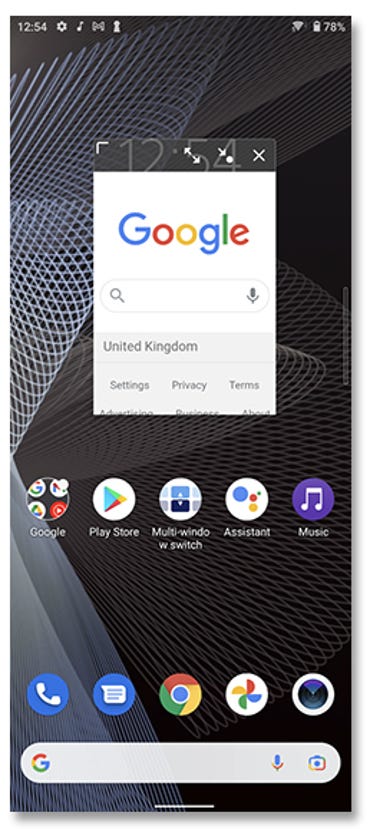
Sony’s Side Sense app lets you open an app in a floating resizable window.
Image: Sandra Vogel / ZDNetSony has cut down a lot on apps that are forced downloads on top of Android 11, although the Xperia 10 III does include Amazon, Netflix, Linkedin, Facebook, and its own music and PlayStation apps, among others. In all, 24GB of the pre-installed 128GB of storage is consumed out of the box, leaving 104GB free. As noted earlier, you can boost the storage capacity with a MicroSD card, albeit at the expense of a second SIM card.
Despite this handset’s relatively small size, Sony includes its three usability tools — Side Sense, Multi-window, and a one-handed mode. You double-tap the screen’s right edge to call up Side Sense, which offers access to one-handed mode (a shrunken screen that’s easier to sweep because of its smaller size), shortcut buttons to frequently used apps, and the option to open an app in a floating pop-out window that you can move around and resize.
Multi-window offers a split screen view. Some pairs of apps are already configured, but you can easily select your own apps. This feature isn’t as usable on the Xperia 10 III’s relatively small 6-inch screen as it is on some larger phones, but you can change the relative size of the upper and lower portions, and some users may find it useful.
The 8MP f/2.0 front camera is unremarkable, although mugshots can be enhanced via a range of tweaks in Portrait Selfie mode. There are three cameras at the back: 12MP f/1.8 wide angle; 8MP f/2.2 ultra-wide angle (120°); and 8MP f/2.4 telephoto (2x optical, 10x hybrid). The optical zoom is accessed by tapping an on-screen button; digital zoom requires an initial screen pinch, then either more pinching or using an on-screen slider. The zoom process feels a bit fiddly, and digitally zoomed shots quickly lose fidelity.
The Xperia 10 III works fine for point-and-shoot images, but there’s nothing here to attract serious photography fans (no macro mode, for example), and low-light shooting is particularly lacklustre. Like the previous model, the Xperia 10 III shoots 4K video at 30fps.
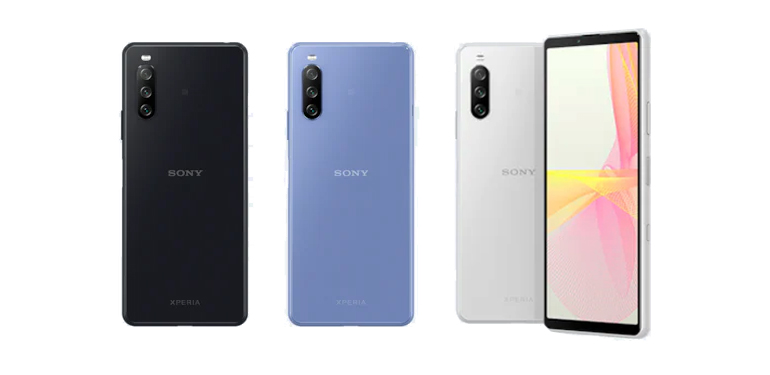
The Xperia 10 III comes in black, blue and white, with Gorilla Glass 6 protection front and back.
Images: SonyThe Sony Xperia 10 III has a 4500mAh battery, a big step up from the 3600mAh battery in the non-5G Xperia 10 II. From a full charge, the PCMark for Android Work 3.0 battery life test came in at 14 hours 51 minutes — about 40 minutes shy of the 15h 30m we recorded for last year’s Xperia 10 II and well ahead of the top-end Xperia 1 III’s 10h 27m.
In my informal test, playing three hours of YouTube video caused the Xperia 10 III’s battery to drop from 100% to 83%, suggesting over 17h on a linear extrapolation. Unless you’re a serious consumer of video content, you should easily get a day’s use from this phone, and may often go two days between charges under light workloads.
My review handset was missing a Sony power adapter, so I used a basic charger I had to hand for testing. This unfortunately ruled out the fast-charging capability listed on Sony’s spec sheet. On one occasion when battery life had slipped to 2%, a 15-minute period of charging raised the battery to 17%; after 30 minutes the battery was at 31%; and after 45 minutes it had reached 44%. If you regularly run demanding workloads and are likely to need the fast-charging, Sony’s 30W Fast Charger XQZ-UC1 is sold separately for £49.99 (inc. VAT).
Conclusions
Like its stablemates, the Sony Xperia 10 III is to a large extent defined by its 21:9 screen, whose benefits will only really be felt when you’re watching video shot with that wide aspect ratio. The build quality is solid and it’s nice to see 5G support, but in other respects this feels like a phone whose price tag is too high. The 60Hz screen refresh rate, an unremarkable camera setup, and lack of fast charging out of the box do it no favours.
If budget is a key factor, you should look at the Moto G50 which for £199.99 almost matches the performance of this £399 handset, while a comparator closer to Sony’s asking price is the £359 Samsung Galaxy A52, which adds a 120Hz screen refresh rate into the mix.
RECENT AND RELATED CONTENT
Sony Xperia 10 II review: An affordable but disappointing wide-screen experience
Sony Xperia 1 III review: An expensive flagship phone with a superb 21:9 screen
Motorola Moto G50, hands on: Affordable 5G, with impressive battery life
Samsung Galaxy A52 5G review: A serious mid-range 5G contender
Best cheap phone 2021: Flagship features on a budget
Read more reviews




















